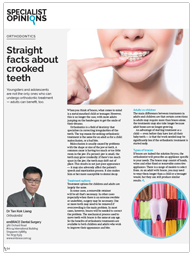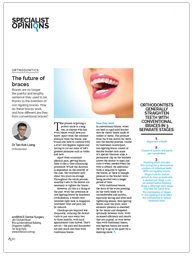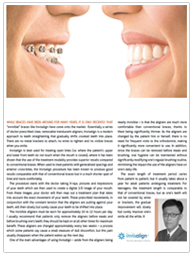ACTING AS A BRACE FOR BRACES, ORTHODONTIC ‘MINI’ IMPLANTS AID IN THE ALIGNMENT OF TEETH DURING BRACES TREATMENT. HERE’S WHAT YOU NEED TO KNOW ABOUT ‘MINI’ OR ‘MICRO’ IMPLANTS.
What are orthodontic ‘mini’ implants? How do they work and how long must I use them?
Orthodontic mini implants, also known as orthodontic micro implants, are small titanium screws that are inserted into the jaw bone to act as an anchor to aid the alignment of teeth. In the past, headgear was prescribed to fix severe tooth misalignment or severe bite problems in older patients (typically those in their teenage years). Cumbersome and unsightly, the gear had to be worn for 14 hours or more a day. In some cases, jaw surgery was traditionally done to match upper teeth with the lower ones.
Orthodontic mini implants are a preferred choice today because they are significantly smaller and hidden away from view. Mini implants reduce the need for major surgery under general anaesthesia. These implants, placed above the gum line of the teeth, act as an immovable anchor point. An elastic chain or spring is used to connect the implant head and the tooth — or teeth — that needs to be moved. The implants are usually left in the mouth for the full duration of orthodontic treatment, and only removed after the braces are no longer needed.
What kinds of problems can mini implants fix?
Mini implants, used in conjunction with braces, can help to reposition either individual or groups of teeth. They can be used to correct an impacted tooth that is positioned far away from the dental arch. Realigning an impacted tooth with an implant will move it back into place and prevent neighbouring teeth from becoming crooked. Implants can also be used to position groups of teeth to move them either forwards or backwards as needed. Multiple teeth can also be moved upwards to expose less gum and reduce the appearance of a ‘gummy’ smile.
What is the mini implant procedure like? Will it hurt?
Orthodontic mini implants are tiny. The procedure to place them is a simple one done under local anaesthesia, so you will not feel any pain. During the procedure, the orthodontist is guided by an X-ray of the position of the teeth so as to avoid any sensitive tooth roots. Placement can be done in mere minutes, and there is usually very little bleeding. Pain after the insertion is minimal and can be controlled with painkillers if desired.
How will I benefit from opting for orthodontic mini implants to fix my severe bite problem?
The biggest benefit to using orthodontic mini implants in addition to braces is that, in many cases, they do away with the need for jaw surgery. The procedure is safe and almost risk-free in the hands of a skilled clinician. After the braces and implant have done their work and are removed, the bone and gums will heal completely.

























